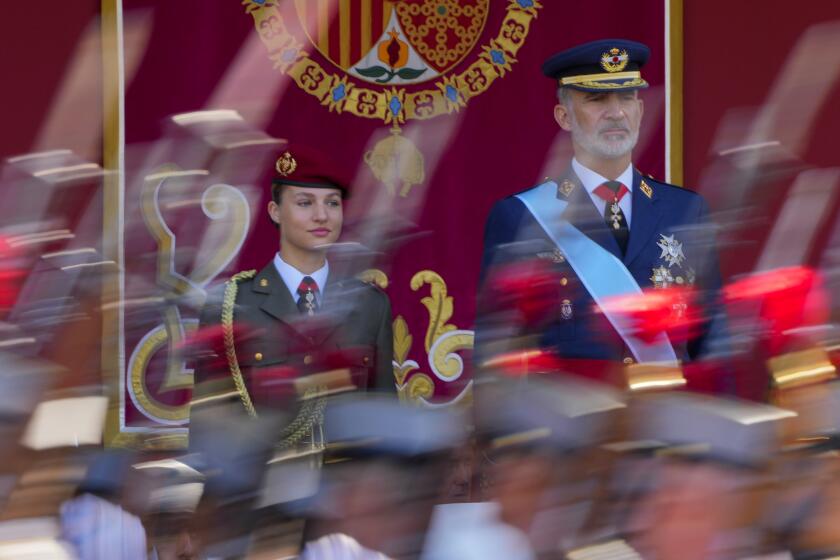Stanford Wins Desert Race by a Microchip
Stanford University’s robot racing team Sunday was declared the winner of $2 million in the Defense Department’s Grand Challenge race to develop an autonomous vehicle that could become a model for battlefield robots.
The team’s technology-laden robotic vehicle, a converted Volkswagen sport utility vehicle named Stanley, navigated a 131-mile course in the southern Nevada desert in 6 hours, 53 minutes and 58 seconds, beating the second-place finisher, Carnegie Mellon University’s Sandstorm Humvee, by about 11 minutes.
The race was Saturday, but a winner was not declared until Sunday, after race judges computed the results.
“This was absolutely incredible,” said Anthony Tether, head of the Defense Advanced Research Projects Agency, or DARPA, which sponsored the race. Tether presented a giant facsimile of a check to the blue-shirted Stanford team, which cheered and poured champagne over one another.
“This has been mind-blowing,” said Stanford team leader Sebastian Thrun as hundreds of spectators near this small gambling city on the California border cheered. Thrun saved his champagne to pour over Stanley, whose future probably will be in a museum in Germany, the home of team sponsor Volkswagen.
Thrun said the technology used in Stanley could be adapted to passenger cars, potentially saving thousands of lives each year.
DARPA’s goal when it opened the competition in 2004 was to encourage development of vehicles that could operate autonomously in war zones, meeting a congressional mandate that 30% of the military’s vehicle fleet be robots by 2015.
The technology of robotic vehicles “is no longer a toy,” Tether said. Stanley’s average speed of 19.1 mph is in the range that military convoys travel, he said. Several of the teams have appointments scheduled with the Army in coming weeks, Tether said.
In the first competition last year, which offered a $1-million prize, no vehicle went as far as eight miles. This time, all but three of the 23 finalists went farther.
Five teams completed the course, which wound over cattle grates, through tunnels under Interstate 15 and into the Lucy Gray Mountains.
“These vehicles haven’t just achieved world records, they’ve made history,” Tether said.
Placing third in the competition was Carnegie Mellon’s second vehicle, a Humvee named Highlander, which crossed the line in 7 hours and 14 minutes. The other two vehicles completing the course were the Gray Team of Metairie, La., which finished in 7 hours and 30 minutes, and Team TerraMax.
Team TerraMax entered a 37,000-pound truck, which sat in the desert overnight after being halted Saturday as night fell. Its unofficial time was 12 hours and 51 minutes.
Although Stanley crossed the finish line first Saturday, it was not immediately clear which vehicle won because the starts were staggered and several vehicles had to be stopped for periods of time on the course.
Most of the vehicles possessed similar technology: laser sensors, a Global Positioning System, radar and cameras. What separated Stanford from the pack, team members said, was a combination of testing experience and software that allowed the vehicle to make good decisions on the fly.
“We spent the last two months in the desert in Arizona,” said Mike Montemerlo, a post-doctoral candidate in Stanford’s Artificial Intelligence Laboratory who was in charge of the vehicle’s software package.
The testing was aimed at increasing the number of miles the vehicle could cover without human intervention. By race day, Stanley had accumulated 412 miles without a problem.
The robots used their GPS to guide them over a programmed course revealed to the teams two hours before the race. Avoiding obstacles and hazards such as boulders, parked cars and precipices required the use of lasers, cameras and radar.
It was up to the computer’s planning software to resolve conflicts and choose an alternate course.
Speed was vital. “Driving fast is much, much harder than driving slow” because the computer must make decisions instantaneously, Montemerlo said.
Stanley, which has a five-cylinder diesel engine, was able to cruise at as much as 35 mph. Highlander was faster, Montemerlo said, but a mechanical failure slowed it down, enabling Stanley to pass it near the end.
More to Read
Sign up for Essential California
The most important California stories and recommendations in your inbox every morning.
You may occasionally receive promotional content from the Los Angeles Times.










